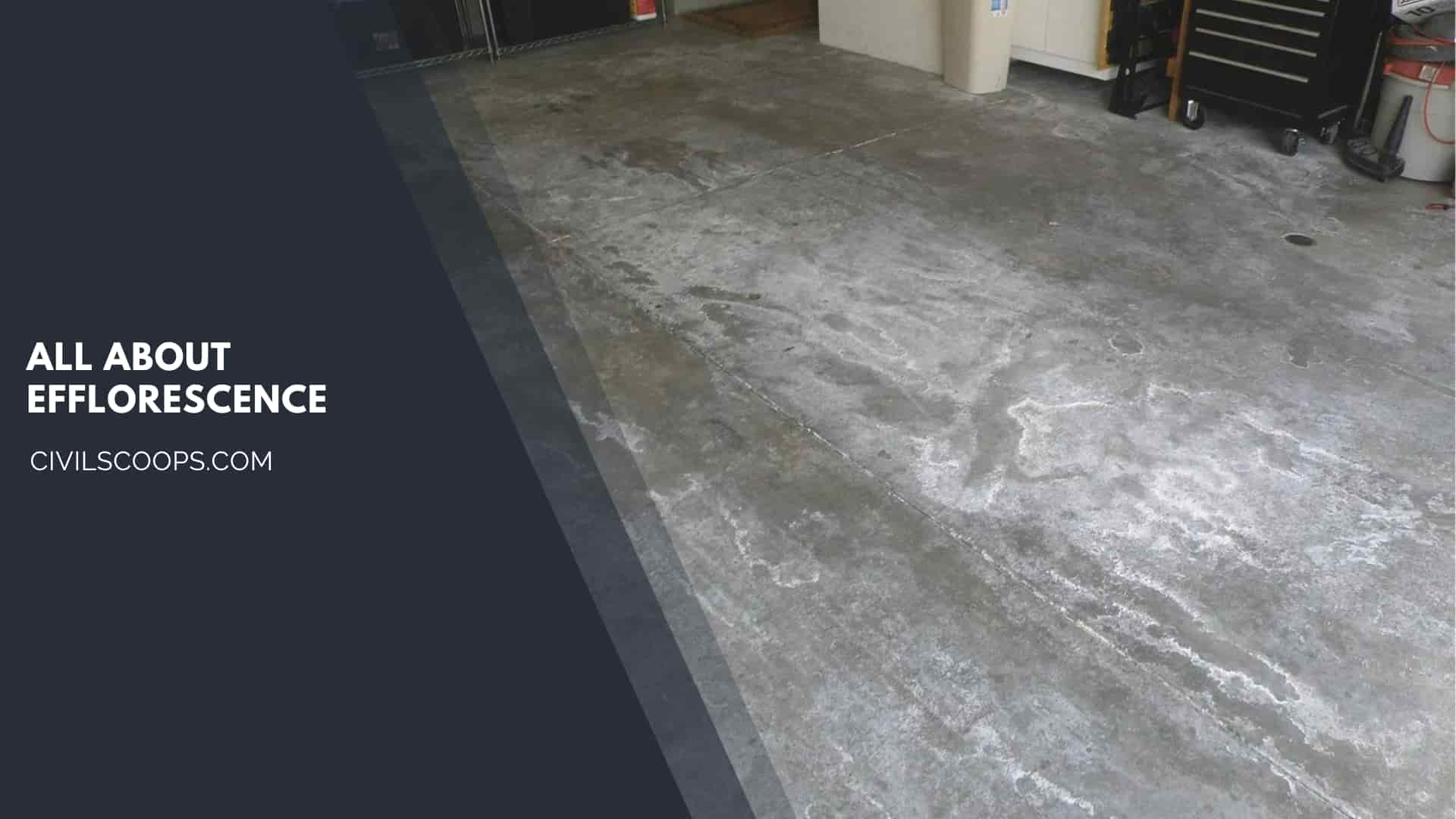
Table of Contents
How to Define Efflorescence?
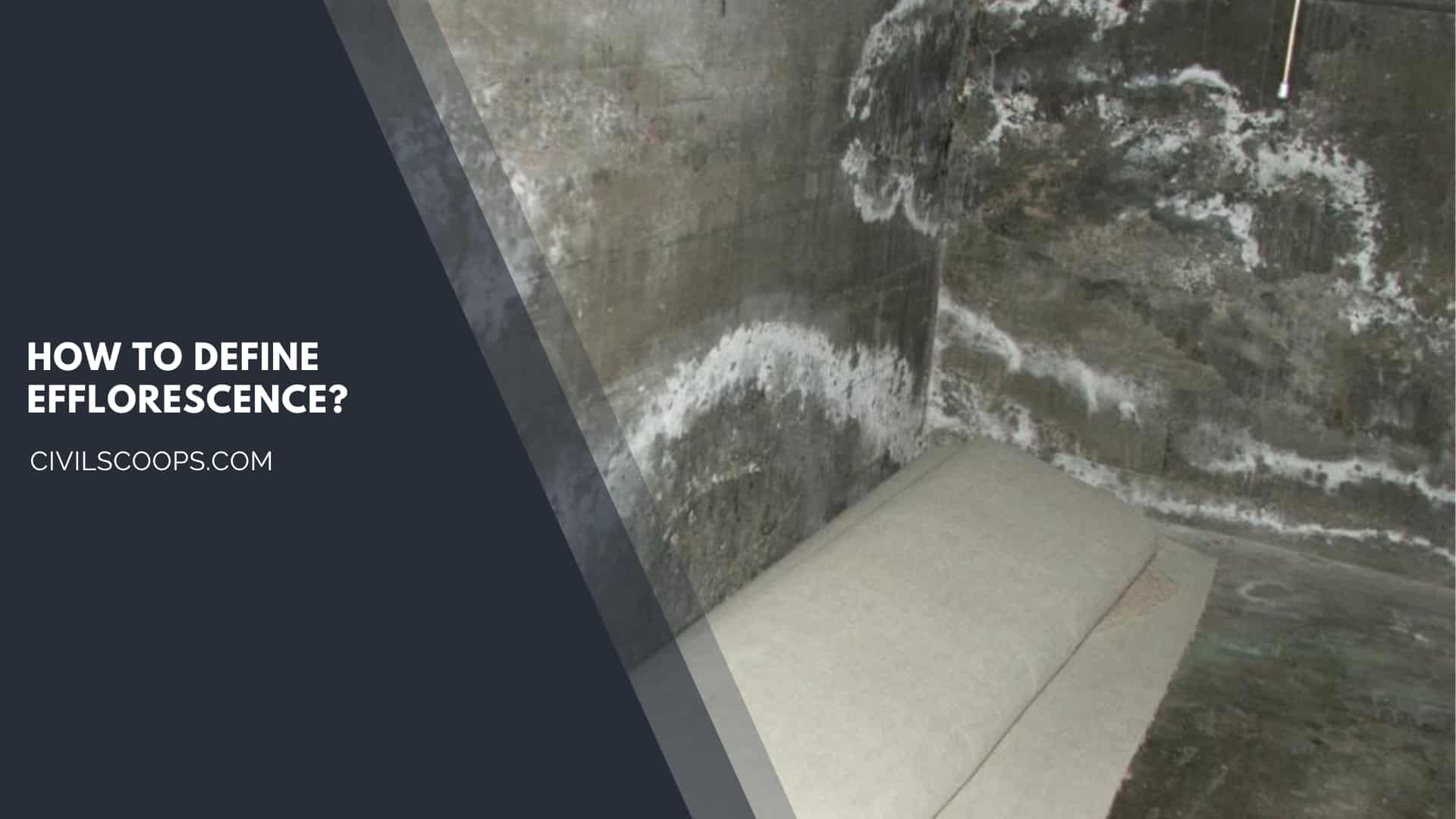
Effloresces, often referred to as the efflorescence meaning, is a crystalline set down of salts that can form when water is present in or on concrete, stone, brick, stucco, or other building surfaces.
It has a white or grayish shade and consists of salt deposits remain on the surface when water evaporates. In addition to it, efflorescence can become visible as a powdery substance on floors and walls and requires particular types of care to treat.
It is caused due to water-soluble salts are there in the concrete material, which comes on to the surface during evaporation of water from the concrete.
How Efflorescence Take Place in Concrete?
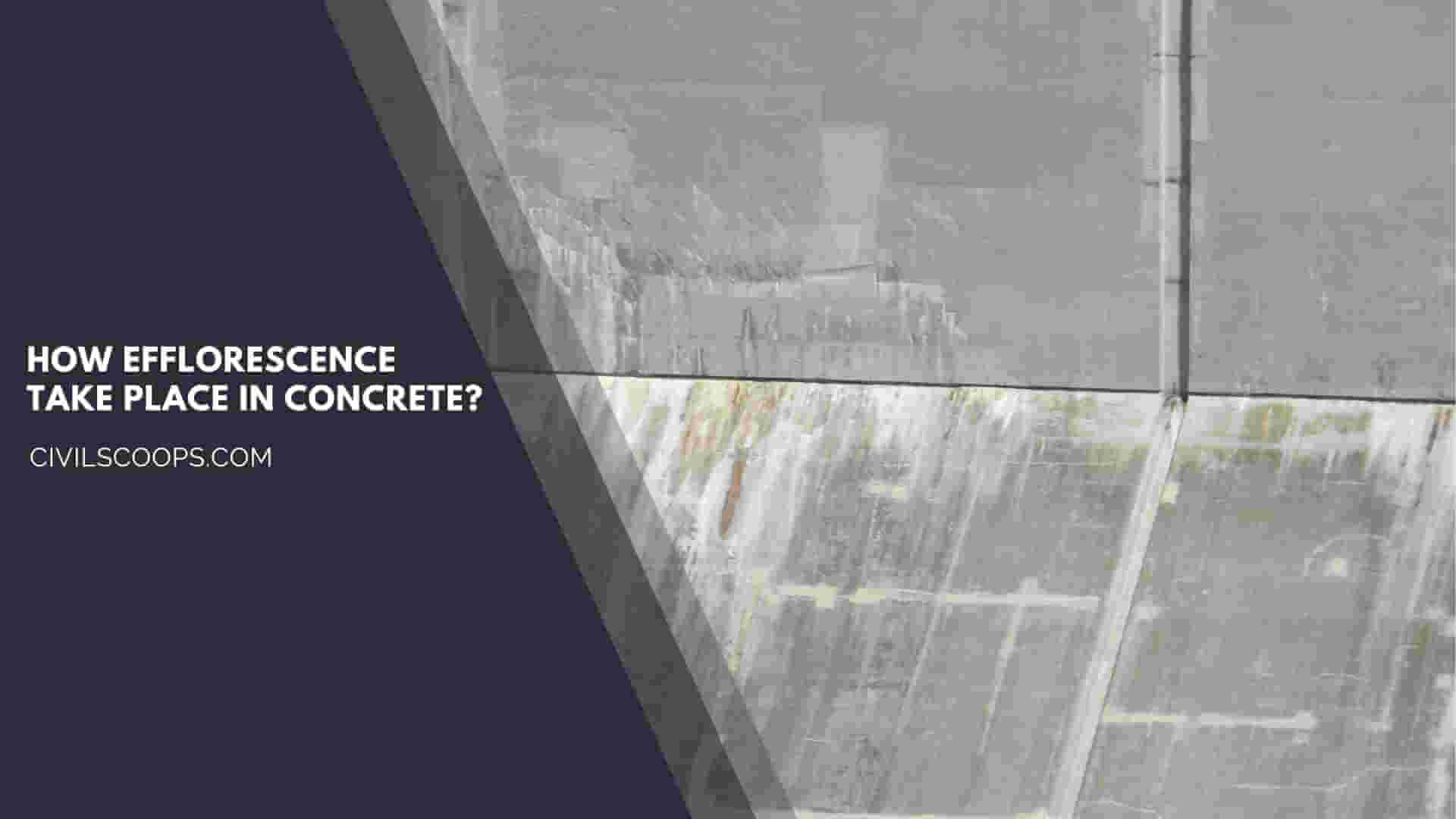
The generation of efflorescence in concrete, or the efflorescence definition, is factored by many external factors which are given underneath. This phenomenon is often studied in efflorescence in chemistry.”
- If there is a problem in curing concrete, the hydration process remains incomplete. By which the un-hydrated products come out near the surface of the concrete.
- Existent of salts in one of the materials of concrete. Generally, salts are mostly found in the fine aggregate or sand is taken out from the river beds.
- The slow rate of evaporation of water proving more time to salts to come out on the surface (the main reason why efflorescence cases appeared to be more during the winter months, on another hand during summer, high temperatures may cause evaporation fast. Hence it has fewer chances to appeared on the surface).
- The water used in the concrete mix is beyond the limit; it causes the concrete porous. Hence need to release extra water and salts to erupt on the surface and for efflorescence.
- During wet weather conditions mainly in the rainy season, the excess water acts as a path for the salts to carry on the surface of concrete and form a white crystalline powder.
- The variableness of concrete (curing or compaction) can result in localized problems where water can saturate more quickly through the concrete.
Various Type of Salts Presence in Efflorescence:
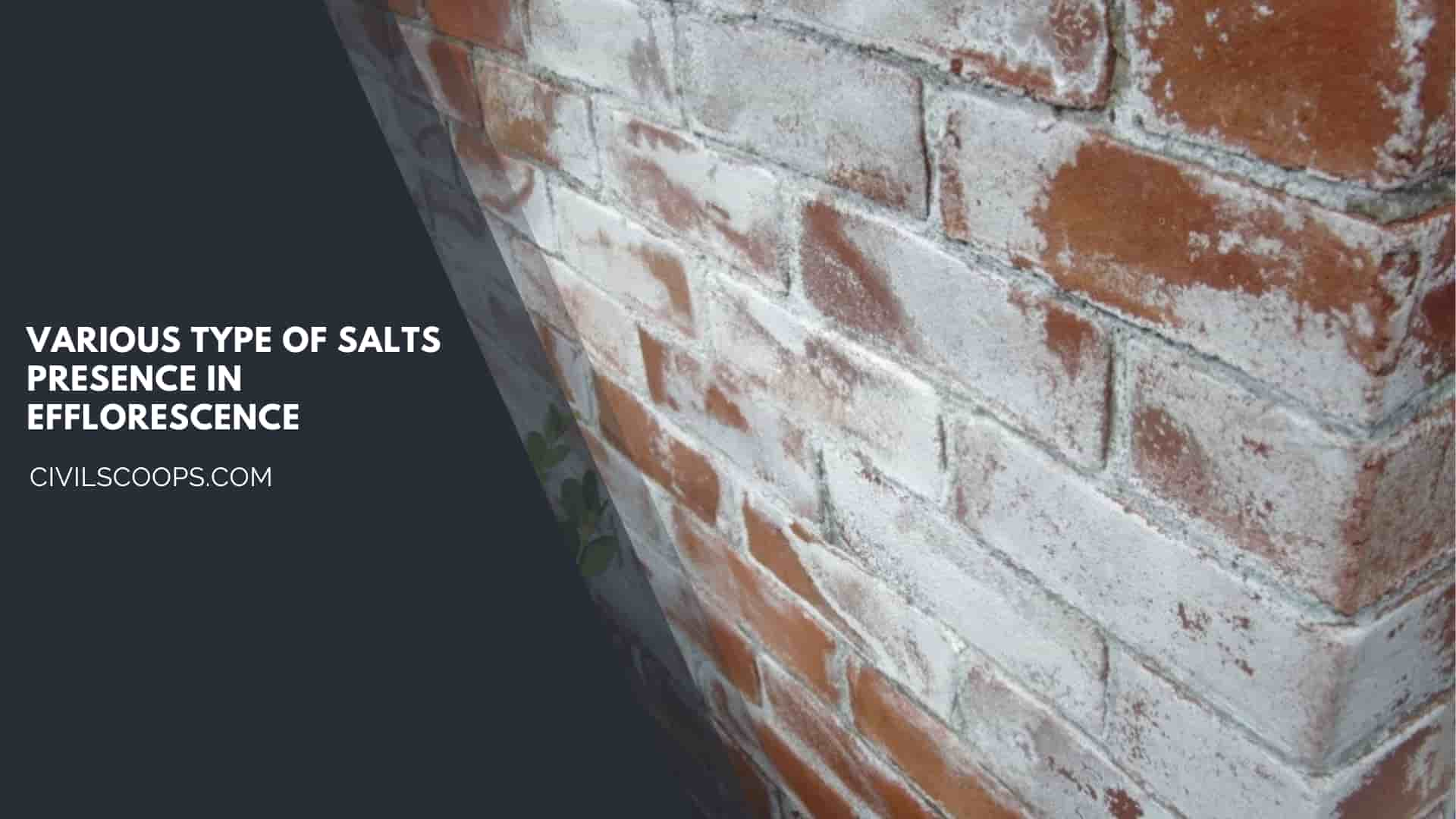
- Sodium Carbonate
Frequently seen easily in a mortar. - Calcium Sulphate
Brick is chiefly source in a common efflorescence. - Sodium Sulphate
Often cement-brick reactions cause this problem. - Vanadyl Sulphate
Usually and easily found in brick. - Potassium Sulphate
Visible in many cement-brick reactions. - Calcium Carbonate
It may be discovered in mortar or concrete backing. - Potassium Carbonate
Like sodium carbonate, typically found in mortar. - Manganese Oxide
Often visible in brick.
Also Read: What Is Classification of Bricks | Classification of Bricks Different Base
Useful Article for You
- How Wide Is a Cinder Block
- How Much Is a Coffered Ceiling
- How to Make Mortar
- How Long Does Hempcrete Last
- How to Use a Hand Sight Level
- How to Construction
- How to Build a Lean to Roof
- How Are Tunnels Built
- How to Layout a Building
- How Wide Is a Car Parking Space
- How Do Shear Walls Work
- How to Measure Concrete Slump
- How Are Bridge Foundations Built
- How to Use Washers with Screws
- How Dense Is Sand
- How High Is a Window from the Floor
- How to Fix Spalling Concrete Foundation
- How Does a Beam Bridge Work
- How Do They Pour Concrete Under Water
- How Does a Sewer System Work
- How High Are Countertops
- How to Seal Brick Wall Interior
- How to Resurface Cement
- How to Use Portland Cement
- How Is Plaster Made
- How to Find Fineness Modulus
- How to Get Rid of Spray Paint Smell on Metal
- How Many Types of Slope Are There
- How Big Is a Stair Landing
- How Does Rebar Help Concrete
- How to Identify a Load Bearing Wall
- How to Get Paint Off Concrete Without Chemicals
- How to Fix Water Damaged Drywall
How to Avoid Efflorescence in Concrete?

When considering efflorescence in cement, the following preventive methods can be used to prevent efflorescence in concrete, showcasing the various brake types used in vehicles.
- Installing a vapor obstacle to prevent the movement of moisture from the subgrade to the surface of a slab.
- The involvement of Class-F fly ash or metakaolin can be fixed up considerable amounts of calcium hydroxide in the concrete.
- The application of sealers and coatings can avoid surface water from penetrating to slabs.
- Preventing the toughened concrete from exposure to moisture by maintaining surface sealers and site drainage, and from growing groundwater by placing a plastic membrane under slabs.
- Waterproofing agents to be used to lessen permeability of concrete.
- Making the concrete denser will decrease the permeability of concrete up to an immense extent.
- Keep away the concrete from premature drying.
Use of specific content, aggregate, cement, and sand, which contains very less amount of salts in it.
How to Exclude Efflorescence in Concrete?
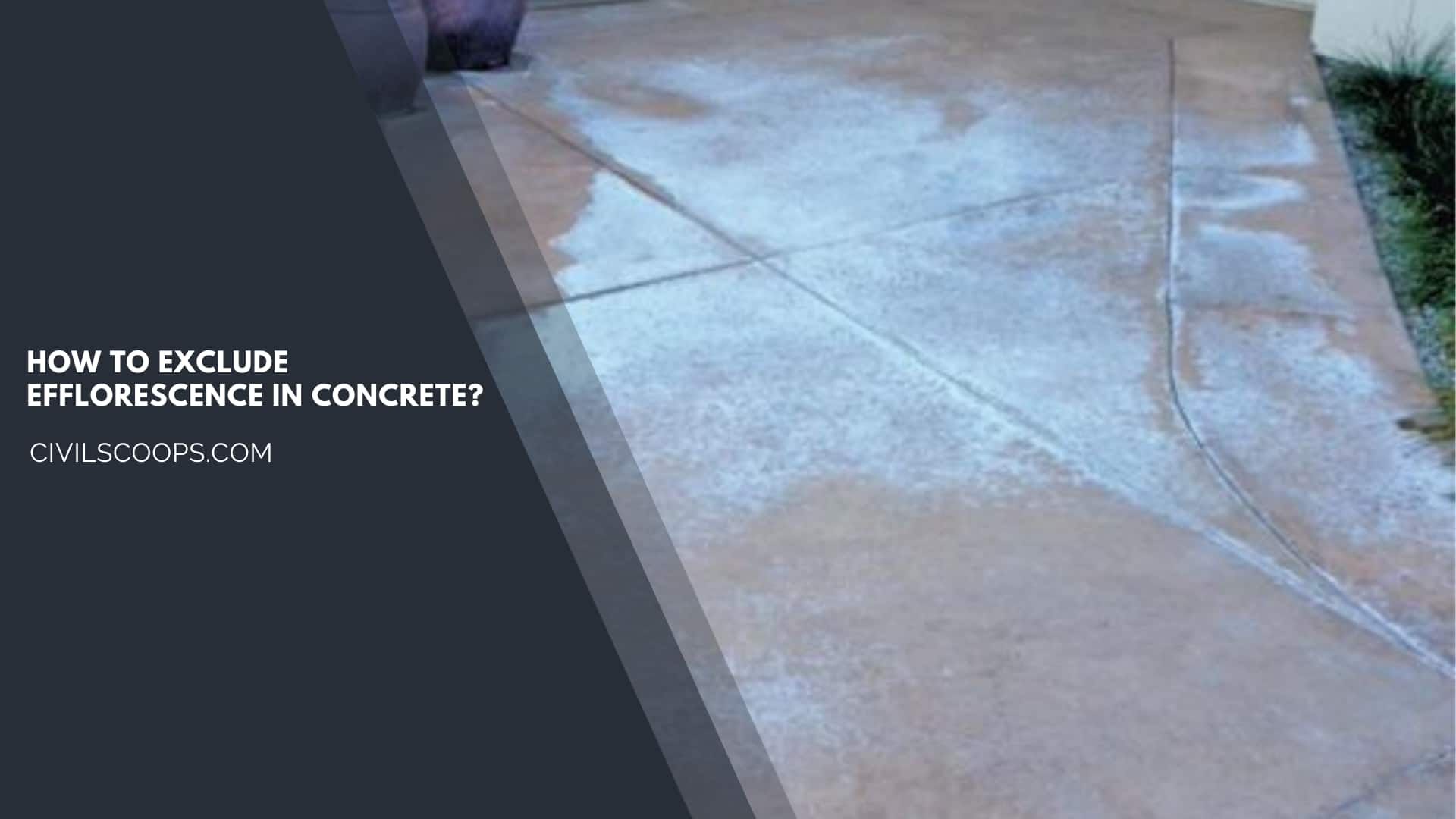
- Before taking steps to the removal of efflorescence in concrete, as an initial step, the resource for the reasons for the efflorescence must be found out and tried to alleviate it.
- Furthermore, the removal of efflorescence can be done by mostly three adaptable methods,
1. Water Jet or Pressurized Water
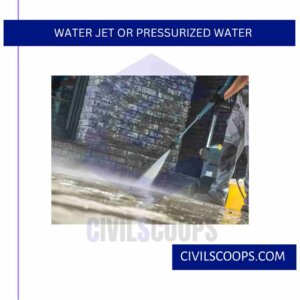
- Firstly, Efflorescence in the concrete can be easily removed by using the high-pressure water jet. Applying high-pressure water may dissolve efflorescence quickly.
- However, care must need to be taken that the water after removing it is dried out. If it remains wet, the same water can create efflorescence on the surface.
Also Read: All About No Hot Water in The House
2. By Using Brush (Hard Teeth)
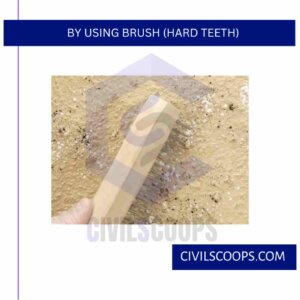
- In rare cases, efflorescence is easily removable; it can be easily removed by using a broom or brush.
- But when the result is not satisfactory by dry brushing, scrub surfaces with clean water then lightly wash the cover.
Useful Article for You
- What Is a Highway Flyover
- What Is Grouting
- What Is a Pile Cap
- What Is a Bond Beam in Masonry
- What Is Sapwood
- What Is Crane
- What Is a Gable
- What Is Superelevation
- What Is Kerb
- What Is the Purpose of Washers
- What Is the Size of a Brick in Inches
- What Is Reinforced Masonry
- What Is Workability
- What Is Bond Breaker
- What Is Plasticizer in Concrete
- What Is Luminous Flux Vs Lumens
- What Is Caisson
- What Is an Undercoat
- What Is a Benchmark Surveying
- What Is Bracing in Construction
- What Is a Beam in Construction
- What Is the Standard Door Frame Size
- What Is a Spandrel Beam
- What Is a Fire Escape
- What Is a Weep Hole
- What Is Tie Beam
- What Is Fine Aggregate
- What Is Pony Wall
- What Is Flag Stone
- What Is Development Length
- What Is Cement Plaster
- What Is a Pitched Roof
- What Is Rafters
- What Is a Slab in Construction
- What Is a Monolithic Slab
- What Is Linear Distance
- What Is Shovel
- What Is Lintel in Construction
- What Is a Concept Sketch
- What Is Mezzanine Floor
3. By Acid Solution (Chemical Uses)
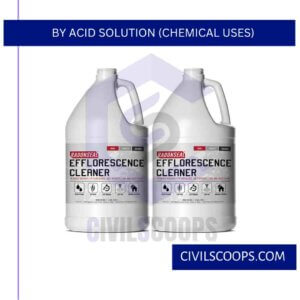
- Firstly, strict warning not to use Concentrated acid directly on concrete, the diluted proportion of 1:20 is used. The surface on which the acid will apply must be moist but without any water(on the cover).
- Keep the applied solution on the affected area for 10 to 15 minutes. The surface should then be thoroughly washed and scrubbed with lots of clean water.
- Do it again at least twice or until all traces of the acid solution have been removed from the surface.
- Acid washing may cause shade variations, and surface texture may get changed. When acid washing is preferable on color finishes, prefer a diluted acid solution (2%,1 part acid to 50 parts water).
- For the initial experiment, apply it to small areas to scrutinized its trial consequences.
- Proper safety criteria must be followed while working with acids in this procedure. Ensure that the working area has sufficient ventilation and avoid direct touch between the acid and steel.
Adoptable Acids in This Work:
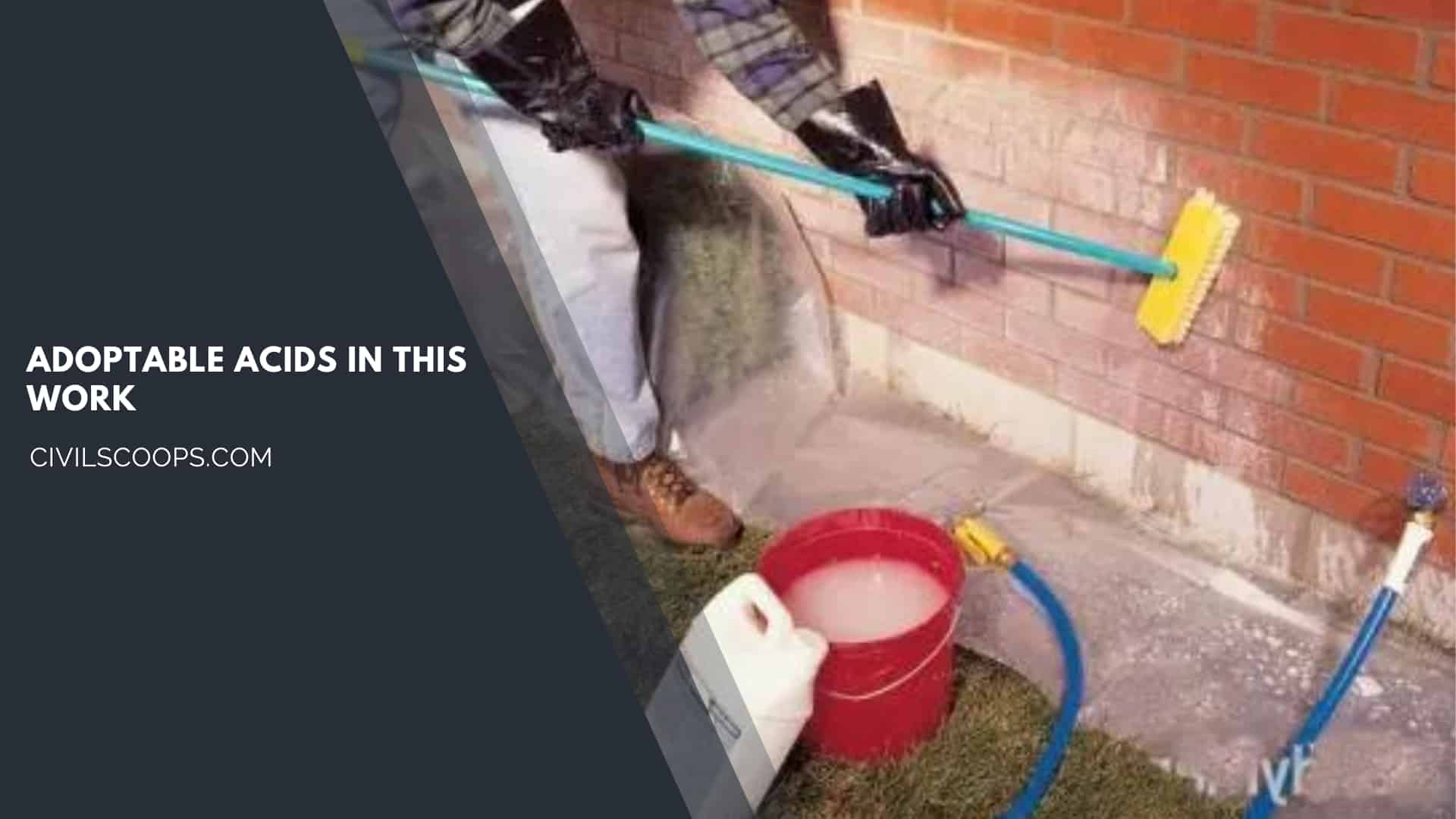
- Phosphoric acid.
- Phosphoric acid.
- Hydrochloric acid.
How to Prevent It?

Easy steps to resist its effects by providing silicone and acrylic coatings may help you to remove efflorescence. This coating will work as an absorber of water throughout a masonry surface and avoid efflorescence from returning. Moreover, the mixture of warm water and white wine vinegar has been exposed to eliminate efflorescence.
- It is using high-quality concrete that contains minimal water. It is known as “low slump” concrete.
- First, make sure the gravel and sand used in concrete have been washed further. More water used in this mixture is pure and salt-free.
- Use low-alkali mortar for brickwork; hence, alkali salts don’t pour into the masonry. Make sure that the chemical used in the manufacturing of fired bricks.
- Consider a sealer or paint, which will give you limited efflorescence. Since some sealers can trap the deposits and make them harder to eradicate, all things are done under expert supervision to get exact positive consequences.
What Is Efflorescence?
Efflorescence is a crystalline deposit of salts that can form when water is present in or on brick, concrete, stone, stucco or other building surfaces. It has a white or greyish tint and consists of salt deposits that remain on the surface after water evaporates.
Is Efflorescence Harmful?
It is common for people to confuse mold with efflorescence. Efflorescence itself isn’t dangerous or harmful.
How to Remove Efflorescence?
In general, most efflorescence can be removed by dry-brushing followed by flushing with clean water.
Cinder Block Efflorescence
Efflorescence is a deposit of soluble salts and bases, usually white in color, that sometimes appear on the surfaces of masonry or concrete construction. Although it may be an aesthetic concern, efflorescence will not affect structural performance. Often efflorescence is apparent just after the structure is completed.
What Is Efflorescence in Concrete?
Efflorescence is a common phenomenon in concrete and masonry structures. It refers to the white or grayish, powdery residue that can form on the surface of these materials over time. This deposit is primarily composed of salts, such as calcium carbonate, calcium sulfate, and other compounds.
What Does Efflorescence Mean?
Efflorescence is a term used to describe the formation of a white or grayish, powdery deposit on the surface of materials like concrete, brick, stone, or stucco. This deposit is typically composed of water-soluble salts, such as calcium carbonate, calcium sulfate, and other compounds.
Yellow Efflorescence on Basement Walls
Efflorescence
Efflorescence is a loose mineral salt that is carried in with the water that infiltrates the concrete, being deposited on the walls during the process. Although somewhat unsightly, efflorescence is harmless and poses no health concerns. It is, however, a sign of humidity.
How to Get Rid of Efflorescence?
Removing efflorescence – three strategies
- Stiff brush. On some smooth surfaces, you may be able to use a stiff brush.
- Water rinse. On other surfaces, rinsing with a garden sprayer or pressure washer can dissolve efflorescence, allowing it to run off.
- Chemical cleaning.
How to Remove Efflorescence from Brick?
Brick Efflorescence Removal Tips
Efflorescence is essentially a salt buildup which also means that it can be removed easily using water. Water can easily dissolve salts. And if added with force using a washer pressure machine, sweeping it all away will take just a minute.
How to Remove Efflorescence from Concrete?
Once the water source is eliminated, most efflorescence (also called Calcium Carbonate or limestone) can be removed with abrasive techniques. Dry brushing, light water blasting or light sandblasting followed by flushing with clean water. In large areas, rotary scrubbers with scrubbing pads may also be used.
How to Clean Efflorescence?
light sandblasting and hosing with clean water. However, some salts become water insoluble shortly after reaching the atmosphere. Efflorescence of this type can be removed with a dilute acid solution (such as one part hydrochloric acid in 9 to 19 parts water or one part phosphoric acid in 9 parts water).
How to Stop Efflorescence?
- Pressurized water: Applying pressurized water may dissolve efflorescence quickly.
- Diluted vinegar: If you’re in a pinch, household diluted white vinegar can be used on efflorescence.
- Brushing: With a strong brush, you can remove efflorescence with ease.
How to Remove Efflorescence from Basement Walls?
The best ways to remove efflorescence: Pressure wash. Applying pressurized water will dissolve the efflorescence. Just make sure to dry off the water from your wall after so it doesn’t reappear.
What Causes Efflorescence in Concrete?
Efflorescence is caused by vapor migrating through the slab bringing soluble salts to the surface of the concrete. Efflorescence is normally worn off or washed away on unsealed concrete surfaces. In stubborn cases, a mild acid rinse or even a light sandblasting may be necessary.
Efflorescence Meaning in Bricks
Efflorescence’ is the term most commonly used to describe the deposit of crusty white mineral salts that appear on a masonry surface (concrete, render, brick or mortar) that have leached out from within the substrate when moisture migrates through it.
Removing Efflorescence from Cinder Block
- Dry brush or scrub with a wire brush.
- Rinse with water.
- Use a vinegar solution (equal parts vinegar and water).
- Rinse again.
- Consider a commercial efflorescence remover if needed.
Like this post? Share it with your friends!
Suggested Read –